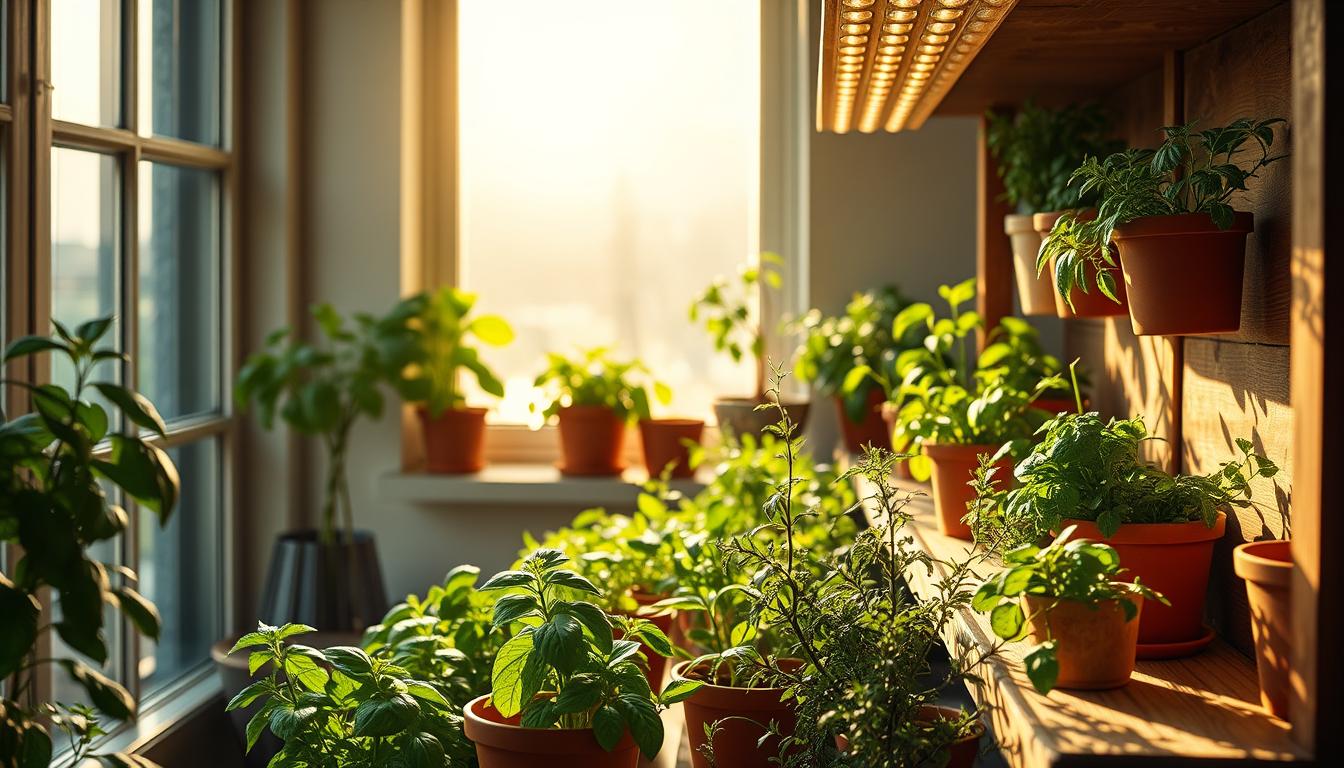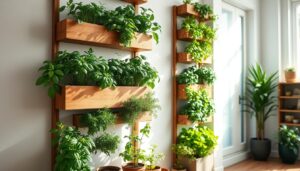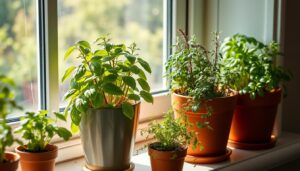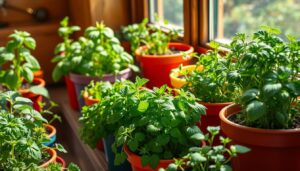Did you know that 87% of indoor herbs fail because of bad lighting? Mastering indoor herb garden lighting can make all the difference. This guide will show you why lighting is so important. It will cover the types of light and how to set it up for healthy, green plants all year.
Key Takeaways
- Lighting is the most critical factor for growing herbs indoors
- Understanding light spectrum, intensity, and duration is key to herb health
- Learn to leverage natural and artificial lighting for maximum plant growth
- Discover the best herbs for indoor growing and their unique light requirements
- Optimize your setup with energy-efficient lighting strategies
Why is Lighting Important for Indoor Herb Gardens?
Light is key for your indoor herb garden’s success. Plants need light to grow and develop. They use light in photosynthesis to make their own food.
Knowing how light affects photosynthesis helps you create the best environment for your herbs.
Understanding the Role of Light in Photosynthesis
Photosynthesis turns light into chemical energy, which plants use as food. This food supports growth, flowering, and other important plant functions. Plants’ leaves catch sunlight and use it for photosynthesis.
The Importance of Different Light Wavelengths
Not all light is good for plants. Blue light and red light are crucial for growth and flowers. UV light and violet light also matter, but green light and yellow light are less important. Sunlight has all these wavelengths, making it perfect for indoor herbs.
Understanding the specific light requirements of your indoor herbs is key to creating a thriving, vibrant garden.
Choosing the Right Herbs for Indoor Growing
Not all herbs do well indoors. Some are perfect for the home’s controlled environment. Focus on basil, chives, mint, oregano, parsley, rosemary, and thyme for a successful indoor garden.
These herbs are great for indoor gardens because they handle limited space and changing light well. They also need more water. Whether you’re new to gardening or have years of experience, these herbs are easy and rewarding to grow indoors.
You can start your indoor herb garden with seeds or cuttings. Seeds are cheaper but take longer. Buying seedlings from a garden center is quicker and easier for beginners.
Starting with seeds or cuttings, with proper care, you can have a beautiful indoor herb garden. Choosing the right herbs means you’re likely to succeed in your indoor gardening.
Understanding Light Requirements for Indoor Herbs
For a successful indoor herb garden, knowing the light requirements of different herbs is key. The amount of light exposure and light intensity affects their plant growth and health.
Categorizing Herbs by Light Needs
Herbs fall into four main groups based on their light requirements:
- Full Sun herbs need at least 6 hours of direct sunlight daily, like basil, rosemary, and lavender.
- Partial Sun herbs do well with 4-6 hours of direct sunlight, including parsley, cilantro, and thyme.
- Partial Shade herbs prefer 4-6 hours of indirect or filtered sunlight, such as chives, mint, and oregano.
- Full Shade herbs need less than 4 hours of direct sunlight, including tarragon, lemon balm, and most leafy greens.
Symptoms of Inadequate or Excessive Light
It’s important to watch the light exposure and light intensity your indoor herbs get. Not enough light can cause slow growth, weak stems, and less flavor. Too much light can lead to wilting, scorching, and discoloration.
| Light Condition | Symptoms |
|---|---|
| Inadequate Light | Slow growth, weak stems, pale leaves, lack of flowering |
| Excessive Light | Wilting, scorching, discoloration, stunted growth |
By knowing the light requirements of your indoor herbs and watching for light-related problems, you can make the best environment for your plants.
Maximizing Natural Light
Using natural light is key for a successful indoor herb garden. The right window placement and knowing how window glass affects light transmission can boost your plants. This lets them get the sunlight they need.
Positioning Plants Near Windows
Putting your herb plants near windows is important. Try to place them right next to the glass. This way, they get lots of natural light all day. It helps them get the sunlight they need for photosynthesis.
Effects of Window Glass on Light Transmission
The kind of window glass you have affects how much natural light your plants get. Uncoated glass windows let about 90% of light through. Double-pane windows with no coating let in around 81%. Low-E windows block some UV light, letting 75-78% of visible light in.
| Window Type | Light Transmission (%) |
|---|---|
| Single-pane uncoated glass | 90% |
| Double-pane uncoated glass | 81% |
| Low-E (low emissivity) glass | 75-78% |
Knowing how window placement and window glass change light transmission helps you place your plants right. This way, you can make the best use of natural light for your plants.
Artificial Lighting Options
Choosing the right lighting is key for a healthy indoor herb garden. You have two top options: fluorescent and LED grow lights. Each has its own benefits, so knowing the differences can help you pick the best for your garden.
Fluorescent Grow Lights
Fluorescent grow lights are a favorite among indoor gardeners. They’re cheaper and use less energy than old-style bulbs. There are two main types: T5 and T8. T5 lights are brighter and use less energy, perfect for adding extra light or as the main light source.
LED Grow Lights
LED grow lights are the latest in indoor gardening tech. They’re cool to the touch and safe for your plants. LEDs vary in size and spectrum, letting you match the light to your herbs’ needs. They last a long time and use little energy, making them a top choice for gardeners.
| Feature | Fluorescent Grow Lights | LED Grow Lights |
|---|---|---|
| Energy Efficiency | Moderately Efficient | Highly Efficient |
| Heat Emission | Moderate | Low |
| Lifespan | Shorter | Longer |
| Light Spectrum | Limited | Wide Range |
| Cost | Lower | Higher |
When picking between fluorescent and LED lights for your herbs, think about energy use, heat, spectrum, and cost over time. These factors will help you choose the best lighting for your indoor herb garden.
Setting Up an Indoor Herb Garden with Grow Lights
Creating an indoor herb garden with grow lights lets you enjoy fresh herbs all year. It’s perfect for any climate or small outdoor space. With these easy steps, you can make a vibrant indoor herb garden setup. This will give you a lot of herbs and make your home brighter.
First, pick a good spot for your indoor herb garden. Look for a place with lots of natural light or where your grow lights can go. Make sure the containers are close to a power outlet for your grow lights.
- Choose containers with drainage holes for better water flow. This stops water from pooling and lets the potting soil dry out as needed.
- Use potting soil made for indoor herbs that’s full of nutrients.
- Plant your herb seeds or seedlings carefully, giving them enough space to grow.
- Place your grow lights 12 inches above the herbs for the best light.
- Water your herbs well and feed them a balanced liquid fertilizer once a month for strong growth.
By doing these things, you’ll soon have a great indoor herb garden. It will give you fresh, tasty herbs all the time. Enjoy making and tasting your homegrown herbs!
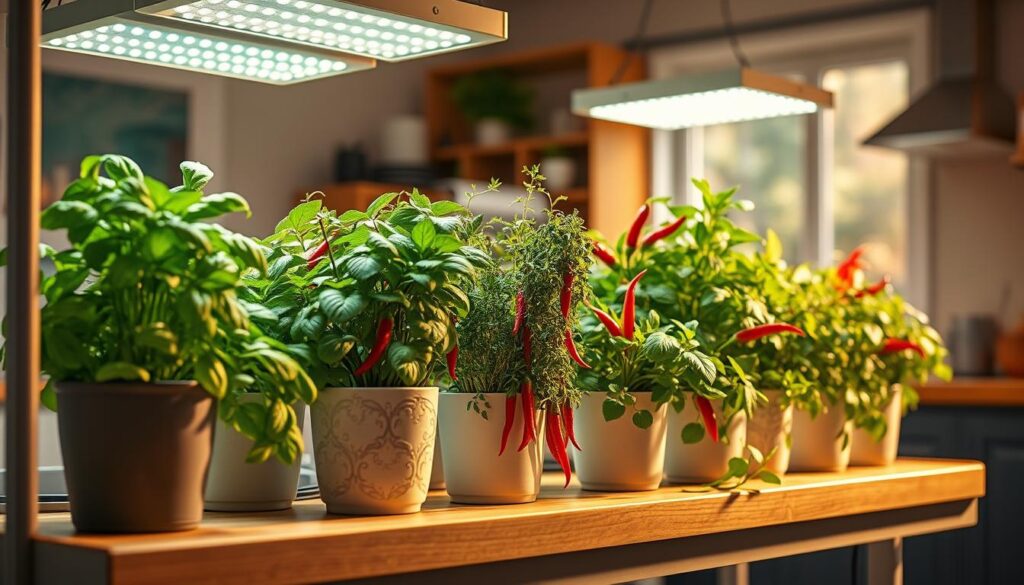
“An indoor herb garden with grow lights is like having a little piece of the outdoors, right in your own home.”
Indoor herb garden lighting tips
For a thriving indoor herb garden, you need more than just the right lights. Here are some key tips to help your herbs grow well:
- Rotate Your Plants: Turn your herb pots a quarter turn every week. This ensures all plants get even light, preventing them from growing uneven.
- Monitor for Pests and Diseases: Check your herbs often for pests or diseases. Deal with any problems quickly to stop them from getting worse.
- Prune and Harvest Regularly: Pruning makes herbs bushier, and harvesting keeps them productive. Cut off leaves or sprigs as you need them to keep your plants healthy.
Follow these indoor herb garden lighting tips for a lush, easy-to-maintain herb garden at home.
| Maintenance Task | Frequency | Benefits |
|---|---|---|
| Plant Rotation | Weekly | Ensures even light exposure |
| Pest and Disease Monitoring | Weekly | Prevents problems from spreading |
| Pruning and Harvesting | As Needed | Promotes bushy growth and productivity |
Remember, proper lighting maintenance is crucial for a successful indoor herb garden. By following these tips, you’ll enjoy a lush, flavorful harvest all year.
“The key to a successful indoor herb garden is paying attention to the little details. Rotate, prune, and monitor, and your herbs will thrive.”
Maintaining Proper Light Cycles and Intensity
Getting the right light balance is key for your indoor herb garden’s health and taste. Knowing about light cycles and intensity helps you create the best space for your herbs. This ensures they grow well and taste great.
Adjusting Light Duration and Distance
Most herbs need 12-16 hours of light daily for photosynthesis and growth. The exact time may change based on the herb type and its stage of growth. Adjust the lighting time to meet your herbs’ needs.
Keep your grow lights 12 inches from the plants for the right intensity. This close distance lets your herbs get the light they need to grow strong. Check the distance often and adjust as your plants grow and need more or less light.
| Herb Variety | Light Duration (hours/day) | Light Distance (inches) |
|---|---|---|
| Basil | 14-16 | 6-12 |
| Mint | 12-14 | 8-12 |
| Thyme | 14-16 | 10-12 |
| Rosemary | 12-14 | 8-12 |
Adjusting the light cycle and light distance for your herbs ensures they get the right light intensity. This careful attention leads to a thriving indoor herb garden. It also means a bigger harvest for you.
Energy-Efficient Lighting Strategies
As an indoor herb gardener, saving energy is key. You can cut down on energy use and lower bills without sacrificing your plants’ growth. Here are some strategies to help you do just that.
Using LED grow lights is a great way to save energy. LEDs use much less power and produce less heat than traditional bulbs. This makes them a better choice for your wallet and the planet. By picking the right LED lights and placing them correctly, you can give your herbs the best growing conditions while saving energy.
Also, how you place and adjust your grow lights is crucial. Make sure they’re at the right distance from your plants. Adjust the light’s strength and time based on what your herbs need. This way, you won’t waste energy on too much light, but still give your plants what they need to grow.
| Lighting Type | Energy Efficiency | Heat Generation | Recommended Use |
|---|---|---|---|
| LED Grow Lights | High | Low | Ideal for energy-efficient indoor herb gardening |
| Fluorescent Grow Lights | Moderate | Moderate | Less energy-efficient than LEDs, but suitable for some indoor herb gardens |
By using these energy-saving lighting tips, you can make your indoor herb garden both sustainable and cost-effective. You’ll help your herbs grow well while also reducing your environmental impact and energy bills.
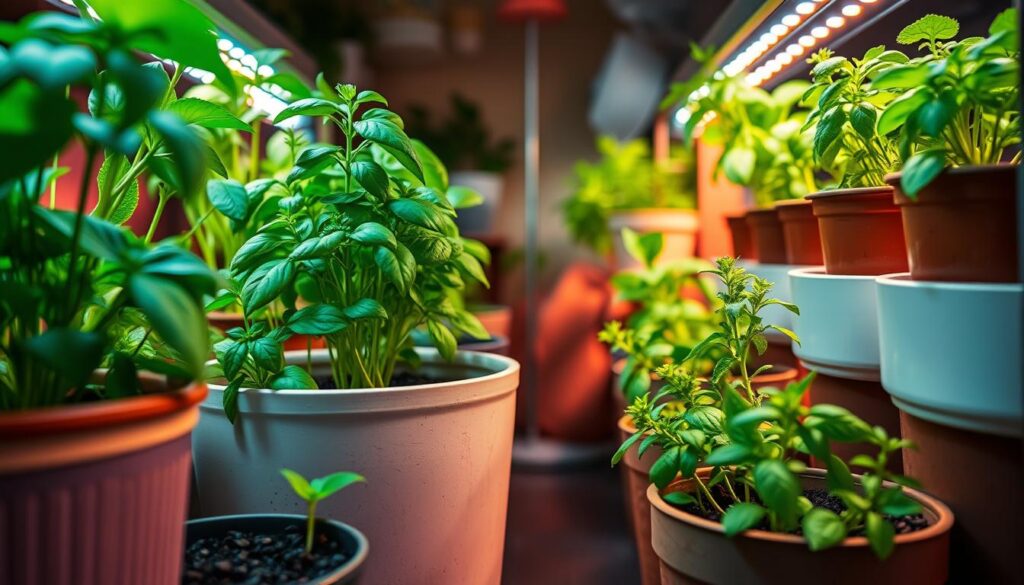
Troubleshooting Common Lighting Issues
Getting the right lighting for your indoor herb garden is key. By spotting common lighting problems and fixing them early, you can help your herbs grow well.
Diagnosing and Addressing Light-Related Problems
Watch how your plants look closely. Signs like slow growth, long stems, yellow leaves, or wilting might mean they need better lighting. If your plants get too much or too little, you can fix this by changing the light’s strength, time, or position.
Checking on your indoor herb garden often and tweaking the lighting can really help. By paying attention and making changes as needed, you can make sure your plants grow well and give you lots of herbs.
“Proper lighting is the foundation for a successful indoor herb garden. With a little patience and perseverance, you can create the perfect environment for your herbs to thrive.”
- Identify the specific lighting-related symptoms your plants are exhibiting.
- Adjust the duration, distance, or intensity of the light to address the issue.
- Monitor your plants closely and make further adjustments as needed.
- Experiment with different lighting strategies to find the optimal solution for your indoor herb garden.
By keeping an eye on your plants and responding to their needs, you can fix lighting issues. This ensures your indoor herb garden is full of plant symptoms, problem-solving, and troubleshooting.
Integrating Lighting with Other Growing Factors
Lighting is key in indoor herb gardening, but don’t forget about other factors. Watering, fertilization, temperature, and humidity are also crucial for your herbs’ health and growth. Combining these elements with lighting creates the best environment for your herbs.
Getting watering right is vital for your herbs to grow and make food. Make sure to water them the right amount and frequency. This depends on the pot size, soil type, and the herb’s needs.
Fertilization is also important for your herbs. Use a balanced fertilizer and follow the instructions. Be careful not to over- or under-fertilize your plants.
Keeping the right temperature is key for your herbs. Most herbs do well in a temperature of 65°F to 75°F. Adjust the temperature in your growing area as needed for your plants.
Humidity affects your herbs too. Aim for a humidity level of 40% to 60%. This helps prevent wilting, browning, or mold. Use a humidifier or mist your plants to keep humidity right.
By balancing these factors with your lighting, you can have a thriving indoor herb garden. Each herb has its own needs, so research and meet those needs for the best results.
| Growing Factor | Optimal Range | Impact on Herbs |
|---|---|---|
| Watering | Frequent, but not excessive | Supports photosynthesis and overall plant health |
| Fertilization | Balanced, nutrient-rich | Provides essential nutrients for growth and development |
| Temperature | 65°F to 75°F | Enables proper enzyme activity and metabolic processes |
| Humidity | 40% to 60% | Prevents moisture-related issues and supports transpiration |
By combining these factors with your lighting, you can make the best conditions for your herbs. This leads to a bountiful and tasty harvest.
Conclusion
Growing an indoor herb garden with the right lighting is rewarding and fun. It lets you enjoy fresh, homegrown flavors all year. By knowing how light helps plants grow and what herbs need, you can make a green oasis at home.
With the right knowledge and effort, you can grow a thriving indoor herb garden. You’ll get a lot of herbs to use in your cooking. This guide gives you the tools to keep your garden full of life and beauty.
Indoor herb gardening with the right lighting improves your cooking and connects you to nature. As you start this journey, try new things, adjust, and enjoy making your indoor herb garden. The tastes and satisfaction you get will show how rewarding it is.
FAQ
Why is lighting important for indoor herb gardens?
What are the different types of light wavelengths and their effects on plants?
What are some of the best herbs to grow indoors?
How much light do indoor herbs need, and how do you categorize their light requirements?
How do windows and window glass affect the light reaching indoor plants?
What are the differences between fluorescent and LED grow lights for indoor herbs?
How do you set up an indoor herb garden with grow lights?
How do you maintain an indoor herb garden with grow lights?
How can you make your indoor herb garden lighting more energy-efficient?
How can you troubleshoot common lighting issues in an indoor herb garden?
Source Links
- Your Ultimate Guide to Growing Herbs Indoors – https://www.eatingwell.com/article/289996/your-ultimate-guide-to-growing-herbs-indoors/
- Your guide to the best indoor lighting for growing herbs – https://herbsathome.co/your-guide-to-the-best-indoor-lighting-for-growing-herbs/
- How to Grow Herbs Indoors with Grow Lights – https://www.gardenersbasics.com/tools/blog/how-to-grow-herbs-indoors-with-grow-lights


